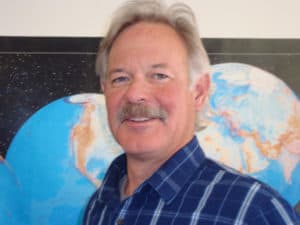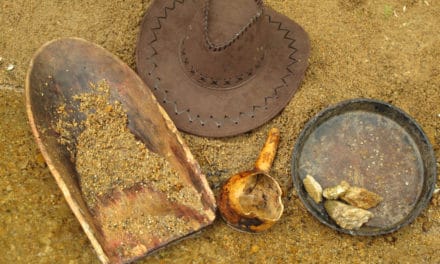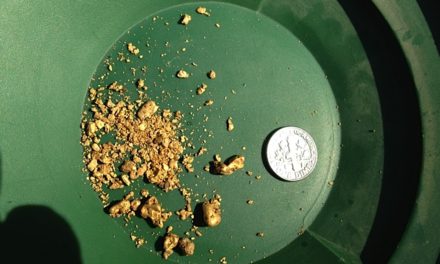By Charles P. Watson
Ever get up on a high bluff or ridge crest and look at the Sierra expanding from the eastern crest to the Sacramento Valley? There is this distinct flat surface that is deeply incised by the several rivers that flow east to west. Some of these valleys are a few thousand feet deep. While compellingly beautiful, the trained eye sees more – much more.
That distinct flat surface that forms the skyline? It represents a time period between 20-40 millions of years ago and long before the Sierra came into existence. It was a time when the Pacific Ocean shoreline was where the Sacramento Valley is today and gentle hills stretched well into Nevada. Large rivers flowed from these highlands and brought sediment down to the ocean. Interestingly, those Nevadan highlands were mineralized with gold and those yesteryear rivers carried a lot of gold all the way to the ocean.
Some of these paleo-rivers flowed for millions of years. Then geologic and/or climatologic changes occurred and they all dried up. But their river deposits were left behind, some of which were hundreds of feet thick. Today, we see these massive rounded quartz-rich sediments left high on the ridges and wonder “How did that get up here?”
You can see these Tertiary deposits in many places in road cuts, like on Interstate 80 between Sacramento and Truckee at Gold Run. Kind of makes you wonder how it got its name, eh? Yet, way up on the ridge many of us just drive by but to the trained eye, it means so, so much more.
Geologists call these auriferous Tertiary gravel deposits because they were loaded with gold. They account for some of the largest bonanza mining deposits located throughout the Sierra. Nearly every county within the Sierra can boast that these deposits were why people came to California in the first place. Ever think how Placer County got it’s name?
But wait – what about those deeply incised valleys? Rivers of today not only cut down into these old Tertiary surfaces but also down within the Sierra bedrock. In some places those rocks were mineralized too! Quartz veins and massive hydrothermally altered rock were eroded and carried down the valleys and out to the ocean. In some cases a few thousand feet of rock was eroded and within them were these gold-bearing rocks.
Now you have two sources of gold in these modern rivers, 1) from the eastern Nevadan highlands, and 2) from the eroded Sierra bedrock. Can you imagine the thrill when the first settlers came to the region and walked down to the riverside to fetch a drink of water, and looking through the water saw all those gold sparkles? The stories of fantastic gold strikes in the rivers, like the Feather, Yuba, American, Cosumnes, Mokelumne, Stanislaus, Merced and Kern. “An ounce of gold in every shovel!” they touted. Epic stories of even more! Tales of prospectors recovering several ounces every day, and stories of even dozens of ounces in an afternoon. Imagine the thrill to see that much gold in one’s pan. It must have been amazing. It is no wonder why these stories caused the largest human migration in this planet’s history.
As a geologist with a trained eye and keen wisdom, I know why it happened, where the gold came from, and where it is now. Yet even still when I’m sitting on that high bluff overlooking the Sierra and see those deeply incised valleys in that old raised Tertiary surface, it still causes me to get goosebumps. To wonder what it would have been like to be one of those first settlers to stumble into one of these valleys and come across that much gold. Shiver me timbers!
Tell your children of these stories. Take them to the mountains and give them a chance to find some gold. Do it next weekend and enjoy a little history that spans millions and millions of years. Look around and become that trained eye. Teach your children what you see and the benefits of gold mining.
Gold mining is not a new thing. It is something in our blood – something that we feel is right. Today’s miners are smarter than ever before. They have better tools to recover the precious metal and the wisdom to work with Mother Nature. Today’s miners are responsible citizens and reclamation is part of their mining process.
It is a thrill to find your first gold speck, flake or nugget. Once you do, you will be hooked forever. It is fun for the whole family and who knows, maybe, just maybe, if you are a wee bit lucky… you too, will jump for joy, click your heels, and shout “Eureka! I found it!”
 Charles P. Watson is the chief geologist at Advanced Geologic Exploration, Inc. located in Chester, California. He is an expert on gold exploration, mining, permitting, and a mining history buff as well. He can be reached at cwatson@advancedgeologic.com or at www.advancedgeologic.com Advanced Geologic locates and sells high quality gold mining claims. They also provide superior mining and geologic consulting, and can assist you with all your mining and permitting needs. The gold rush is on! Contact them and claim your fortune!
Charles P. Watson is the chief geologist at Advanced Geologic Exploration, Inc. located in Chester, California. He is an expert on gold exploration, mining, permitting, and a mining history buff as well. He can be reached at cwatson@advancedgeologic.com or at www.advancedgeologic.com Advanced Geologic locates and sells high quality gold mining claims. They also provide superior mining and geologic consulting, and can assist you with all your mining and permitting needs. The gold rush is on! Contact them and claim your fortune!












